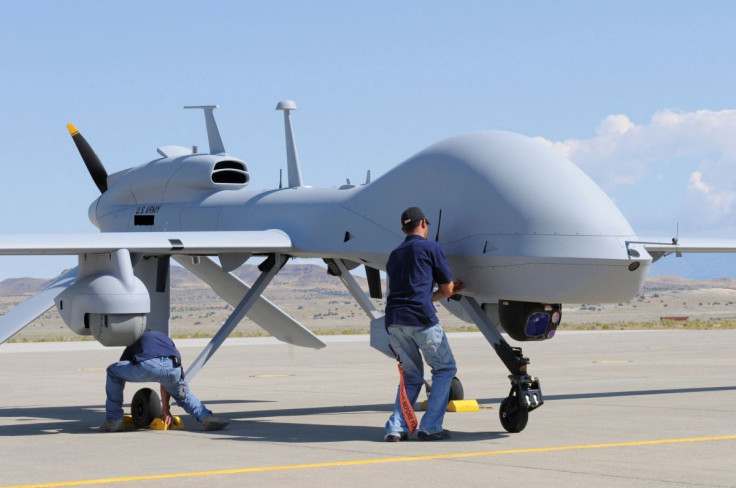Ukraine Asks For Advanced Drones Which US Fears May Fall Into Enemy Hands
KEY POINTS
- Kyiv hopes the Gray Eagle drones and anti-drone missiles will bolster its civilian air defenses
- Ukraine has used the less sophisticated Turkish-made Bayraktar TB2 drones to mixed reviews
- Though initially praised, the TB2 drones are virtually useless in the face of Russian air defenses
To bolster its air defense amid increased Russian use of kamikaze drones, Ukraine has made a new pitch to the U.S. for the supply of advanced drones and anti-drone missiles, despite earlier rejections.
According to Reuters, Ukraine's Defense Minister Oleksii Reznikov has requested Washington for the supply of four MQ-1C Gray Eagle drones in a letter on Nov. 2. The report further adds that Ukraine has for the first time also requested the counter-drone AGM-114L or LONGBOW missile system.
While Kyiv hopes the drones and anti-drone missile systems would bolster its civilian air defenses in the face of Iranian-made kamikaze drones used by Russia, the U.S. has rejected earlier requests of Gray Eagle citing several reasons, including apprehensions that its use could escalate the conflict and fears of the drones being shot down or falling into enemy hands.
The fears are not completely unfounded as it was reported recently that Russia secretly flew a variety of western weapons that included the U.S.-made Javelin anti-tank missile, a Stinger anti-aircraft missile and a British NLAW anti-tank missile captured in Ukraine, to Iran. It raised apprehensions that the seized weapons could offer Iran an opportunity to study the technology used to manufacture these weapons and potentially copy it.
Iran has effectively reverse-engineered American weapons, missiles and drones in the past, as per reports. At least six types of Iran's Shahed drones have been built based on the American RQ-170 which was captured by Iran's Air Force in 2011, a December 2020 report by Iran Press revealed.
Although the report does not elaborate on the type of drones, it is worth mentioning that Shahed-136 are among the Iranian drones that are reportedly being used by Russia to attack key civilian targets in Ukraine.
Ukraine hopes that its latest request for Gray Eagle will be considered by Washington as it is combined with the request for the LONGBOW missile system aimed at protecting civilian lives and infrastructure facilities.
Costing about $10 million each, procuring the MQ-1C Gray Eagle will mean a technological leap for Ukraine. With an operational ceiling of 25,000 feet, the drone is the army's version of the more popular Predator drone.
Gray Eagle can fly up to 30 or more hours, gather huge amounts of intelligence data, and carry up to eight powerful Hellfire missiles.
Since the Russian invasion of Ukraine in February, multiple requests and proposals for the transfer of Gray Eagle have been raised by Kyiv only to be stalled by officials in Washington.
In April, while the U.S. sent several small, expendable drones, Ukraine officials held discussions with General Atomics, the manufacturer of the sophisticated Reaper and Gray Eagle drones, to get these systems as they could travel farther distances, fly at greater altitudes, and be reloaded for additional missions.
Meanwhile, Ukrainian forces have used the less sophisticated Turkish-made Bayraktar TB2 drones to mixed reviews. While during the early days of the conflict, Ukrainian officials praised the Bayraktar drones, and videos and propaganda songs about its capabilities went viral inspiring the Ukrainian resistance, subsequent months have shown the drones were largely ineffective.
Later in June, when the proposal for the sale of Gray Eagle drones to Ukraine was mooted yet again, The War Zone reported that Ukrainian pilots expressed skepticism and dismissed the value of the Turkish-made drones in the face of the enemy.
The pilots told the outlet that the acclaimed unmanned drones had become virtually useless when faced with Russia's robust air defenses.
Compared to the Bayraktar TB2, the Gray Eagle is longer and more capable, with a larger wingspan and twice the takeoff weight.
Apart from being faster than the TB2, the Gray Eagle can, more importantly, carry twice as heavy weapons. Using the Gray Eagle will enable Ukrainian forces to carry out reconnaissance operations and gather intelligence from farther away.
Washington's decision to transfer the Gray Eagle drones was paused in June after the Pentagon's Defense Technology Security Administration raised objections fearing that the sophisticated surveillance equipment of the done might fall into enemy hands.

© Copyright IBTimes 2024. All rights reserved.






















